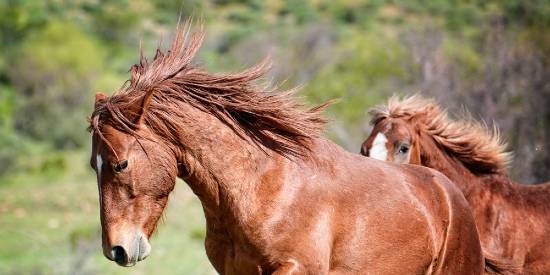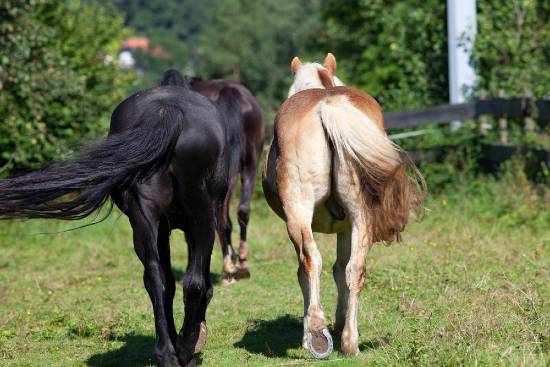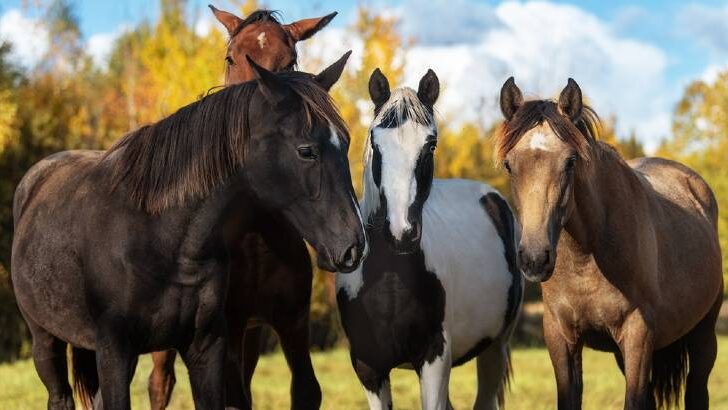Affiliate Disclaimer
As an Amazon Associate I earn from qualifying purchases. It helps me keep the website going. Thank you for your support.
Pasture time and socialization with other horses are vital to the well-being of your horse. Horses are social animals that need time outside with their buddies to play, eat grass, and just enjoy being a horse. But, how do you choose what horses to pair together for pasture and grazing time?
It is important to remember to avoid pasturing and or grazing two horses of the same gender to lower the risk of competition and or aggression. The root of pairing horses together lies in understanding herd dynamics and the hierarchy within your own herd.
Making informed pairing decisions creates a more peaceful and enjoyable turnout time for all involved. Learn more about pasture time and pairing horses by continuing below.

Key Points to Consider When Pairing Horses
The most important points to consider when you pair horses together for pasture are:
- Introduce new pairs slowly- allow horses to get to know each other through neighboring spaces so they can get to know each other, and if they show obvious signs of discomfort or aggression, you can move them before things get worse
- Ensure the pair has similar temperaments- when horses have similar behavior and preferences, they are more likely to get along
- Avoid pairing two dominant horses or horses of the same sex- doing so can increase the likelihood of aggressive or undesired behavior and competition, all of which can lead to injury
- Do not pair together two horses that seem hostile towards each other- this is a recipe for fighting and other aggressive behavior as one may try to dominate the other
- Pasture ponies, minis, and other smaller horses as well as seniors should be paired with with each other to avoid injury from larger, younger, and or more energetic horses
Once you decide on a pairing, your next action should be to make the pasturing experience as comfortable as possible for all horses involved.
Dominant vs Submissive Horses
The term dominant horse has been mentioned several times, but what does it mean for a horse to be dominant?
A dominant horse is one that is usually stronger, braver, or more curious than the other horses in the field. Both mares and stallions/geldings can exert dominance.
A dominant stallion will display signs of aggression and often pick fights with other horses to maintain their superior position.
A dominant mare will have the best patch of grass in the pasture and will push away or invite other horses to join based on their relationship. You can read more about the signs of dominance in horses here.
Submissive horses are more meek and will spend most of their time following the lead of the dominant horse and or doing things with them to build trust.

How to Successfully Pair Horses Together for Pature
To ensure the best possible outcome when pasturing a new pair together, make sure to stay and supervise their interactions for 20-30 minutes. This way, you can know for certain if they are a good fit before leaving them alone.
Horses will squeal and run around the pasture a lot when first introduced. Do not be alarmed, this is part of their way of establishing herd hierarchy and figuring each other out.
In any pasture, the bigger the space is, the better (source). Horses need a lot of room to run and play. You can read more about how much land a horse needs when being pastured here.
Always put the shy horse of the pair out in the pasture first, so that the more dominant horse will not interrupt you by scaring and or intimidating the timid horse
Do not give your horses grain or hay in the field. Horses tend to fight over food, and this will create a negative association with pasture time as well as increase the risk of injury.
Remove halters during pasture time so that your horses cannot snag them on things or get hurt by other horses trying to grab them.
Always separate a regularly aggressive horse from the herd when pasturing, they will cause less stress on their own and would likely do better in the company of a goat or other companion animal.
What Are Signs of Aggression in Horses?
One of the goals of pairing horses properly is to reduce aggressive behavior. How can you tell when a horse is getting aggressive?
Common signs of aggression in horses include:
- Ears flattened toward the head and pointed backward
- Lips pulled back
- Fast swishing of the tail
- Pawing and stomping
- Moving in a snake-like pattern
- Squealing and snorting
- Bowing the head
- Threatening to kick
If you see a horse starting to be aggressive toward the one they are paired with, separate them to prevent the situation from escalating.
Horses are not aggressive without a reason. If they are, they are usually trying to dominate another horse or use it as a last-ditch effort to communicate discomfort or stress.

Benefits of Pasture Time
Horses should be put out in the pasture at least once a day. Being in the pasture allows them to get exercise, socialize with others, and keep them healthy.
Pasture time also strengthens a horse’s musculoskeletal system, This reduces the chance of muscle strain or injury. Horses that are out in the pasture go lame less often and have better, balance, coordination, rhythm, and cadence to their gaits.
Grazing on pasture grass supports a horse’s digestive health. As a horse moves from place to place to graze, their stomach gently contracts to help push the grass along and prevent digestive or intestinal issues.
The saliva that a horse produces in their mouth while chewing grass creates a buffer for stomach acid.
The more time a horse spends outside, the healthier their respiratory system will be. Horses in a stall for excessive periods are more likely to inhale dust and other airborne particles that cause airway obstruction.
Horses that have enough pasture time will be less susceptible to developing vices like cribbing, windsucking, and weaving out of boredom.
Final Thoughts
Knowing how to successfully pair horses together for pasture is all about understanding horse behavior. It also requires an awareness each horses temperament. Herd dynamics inform the ways horses behave when pastured together. Always introduce new pairs gradually before putting them out together to ensure a good match.




